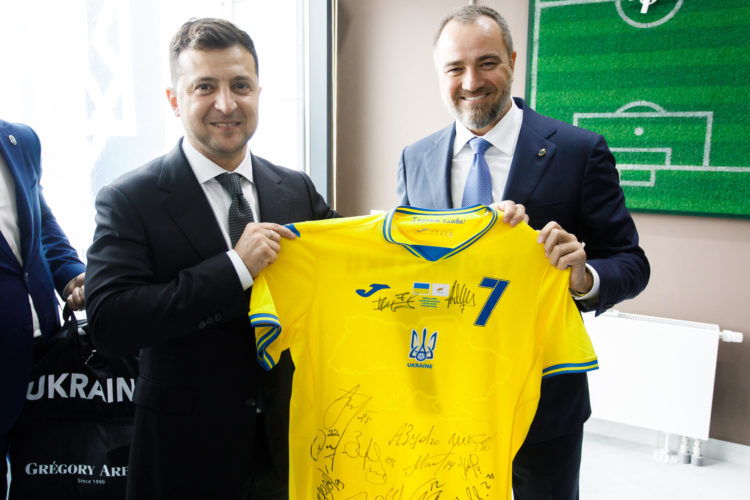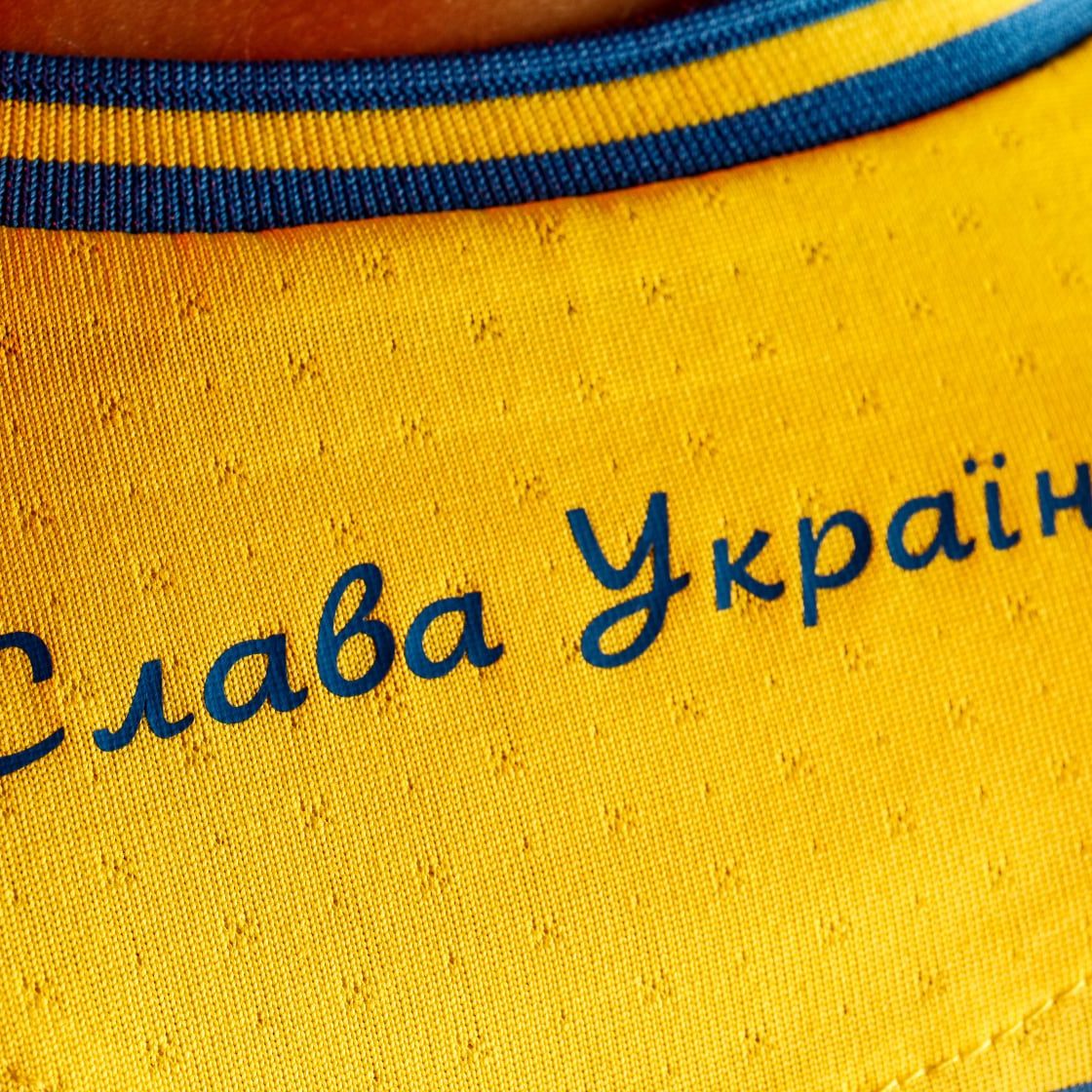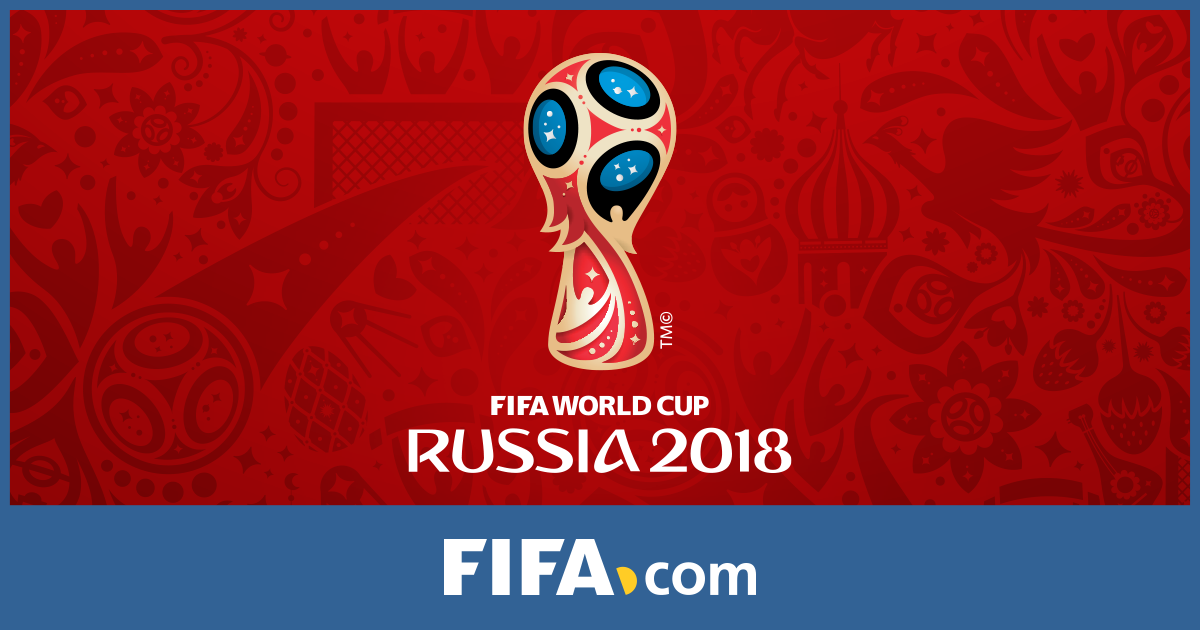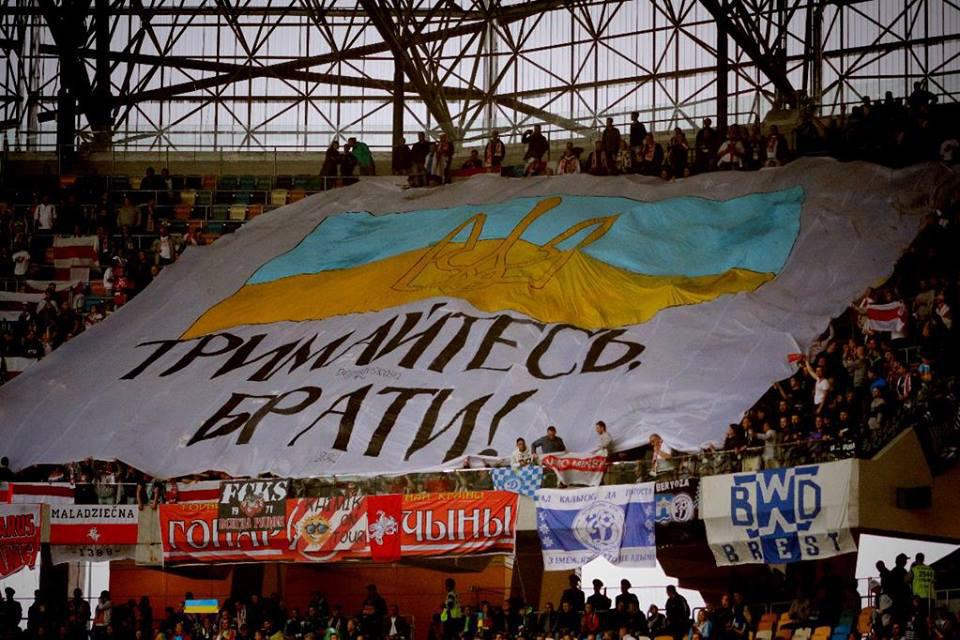cFollowing complaints by the Russian Football Union, UEFA has required Ukraine to remove part of a national slogan depicted on the inside of the collar of the uniform in the run-up to the UEFA European Football Championship Euro-2020 which starts on 11 June.
Despite approving the bipartite slogan “Glory to Ukraine — glory to the heroes” back in December 2020, following Russia’s intervention, UEFA on 10 June decided that while the first part of the slogan is “of general national significance,” the second one is “clearly political in nature, having historic and militaristic significance.”
The slogan is not the only element of the Ukrainian team’s uniform that Russia took issue with: Ukraine had elicited Russia’s fury with an outline of the internationally recognized borders of its country, the Crimean peninsula of which is occupied by Russia since 2014.
UEFA dismissed the map complaint, referring to a UN resolution rejecting the Russian occupation, yet met Russia halfway by banning half of the slogan, used as an official greeting in the Ukrainian Army.
There is no doubt that for Russia, Ukraine’s centuries-long struggle for independence from its sphere of influence is “political.” However, that UEFA has fallen to this imperialist notion is surprising, as is the assertion that one part of the slogan is acceptable while the other is “clearly political”: both are a rallying cry against Russian domination, which is ongoing today.
Origins of the slogan
On June 6, the President of the Ukrainian Association of Football Andrii Pavelko presented the new outfit of the Ukrainian football team. It portrays a map of Ukraine with all parts of its integral territory, including Russian-occupied Crimea. It also depicts the slogan “Glory to Ukraine — Glory to the heroes” (“Slava Ukrayini — Heroiam Slava” in Ukrainian).

The birth of the slogan traces back to the Ukrainian War of Independence 1917-1921. It is believed to have been used in the Black Zaporozhtsi Cavalry Regiment, an armed unit of the Ukrainian People’s Republic (UNR). Back then, the Ukrainian soldiers greeted each other with “Glory to Ukraine!” and the response would be “Glory to the Cossacks!”, referring to the Cossack state which in the 15th-17th centuries fought against Polish rule and is considered one of the progenitors of the modern Ukrainian nation.
Originating from an 1863 poem written by poet Pavlo Chubynskyi to embody dreams of Ukraine’s national independence, it later rose to prominence as one of the official anthems of the UNR and its sister ZUNR, the West Ukrainian People’s Republic, in the ultimately unsuccessful independence struggles of 1917-1920. After Ukraine gained independence following the collapse of the USSR, Chubynskyi’s poem was approved as the country’s national anthem in 1992.
Interestingly, during the Hetmanate period of Hetman Pavlo Skoropadsky in 1918, a quite similar greeting was used. It said “Glory to Ukraine! Glory to the Hetman!”
Ukrainian insurgents of Kholodny Yar, who fought against the Red Army in 1918-1923, chanted “Glory to Ukraine!”
Overall, the second part of the slogan saw many variations, writes historian Yuriy Yyzych on the Ukrainian portal Istorychna Pravda, “Historical Truth”:
- Glory to all nations!
- Glory on all of earth!
- Long live democratic Russia.
- Glory to the Central Council, Glory to the General Committee!
- Glory to the Ukrainian Central Rada!
- Glory to the Ukrainian Black Sea Fleet!
- Long live free Ukraine!
- Glory to the Cossacks! Glory to the Galicians! Glory to the Directory!
- Glory to the Sich Riflemen!
- Glory to the Hetman!
- I serve the Ukrainian nation.
- Glory to Ukraine!
- Glory to Petliura!
- Glory to the Cossacks!
- Glory to the Chief!
- Glory to the glorious Cossack army!
- Glory to its heroes!
The prototype to the slogan “Glory to the heroes” was evident already in 1919, when on 22 January, the Unification act of the Ukrainian lands, uniting the fledgling UNR and ZUNR, was proclaimed in Kyiv. Railroad soldiers were the first to arrive at Sofiyivska Ploshcha, where the act was signed carrying a large national flag, on which the words “Glory to the Ukrainian heroes!” were inscribed.
The bipartite slogan “Glory to Ukraine! Glory to the heroes!” as we know it today was first used by the League of Ukrainian Nationalists (1925-1929; it was a progenitor to the later Organization of Ukrainian Nationalists). Here are recollections of the commander of the 1st cavalry regiment of the Black Cossacks of the Army of the Ukrainian People’s Republic:
“In 1925, Artyushenko, together with Mykola Stsiborsky and other like-minded people, organized the League of Ukrainian Nationalists in Podebrady. When the question of organizational greeting arose, it seemed that it was Yuriy Artyushenko who suggested using the greetings of the Black Cossacks, ‘Glory to Ukraine!’ ‘Glory to the Cossacks!’ The society accepted the offer, but with clarification – it was necessary to answer: ‘Glory to the heroes!’.”
The compulsory status of the response “Glory to the heroes” to the greeting “Glory to Ukraine” is believed to have been officially established in 1941 by the second congress of the Organization of Ukrainian Nationalists (OUN).
This organization, following a brief period of collaboration with the Nazis in hopes that they would aid Ukraine’s independence struggles, proceeded to fight for an independent Ukraine against both the Nazis and the USSR.
Symbolic of this two-pronged fight is the OUN leader Stepan Bandera’s incarceration in the Sachsenhausen concentration camp during WWII and later assassination by KGB agents in Munich in 1959.
While the OUN and the related Ukrainian Insurgent Army, UPA, have their own share of underexplored WWII-related controversies, such as the massacres of Poles in Volyn and possible participation of some members in the Holocaust, these historical complexities should not obscure the fact that it united 200,000 people who fought a war for Ukraine’s independence simultaneously against two totalitarian superstates vying for its territory.

A new life for “Glory to Ukraine”
The first part of the greeting, “Glory to Ukraine!,” is unchanged to this day. Today, Ukraine uses “Glory to the heroes!” as the second part of its national slogan, paying respect to those who gave — and continue to give — their lives for Ukraine’s liberation from foreign rule, as a simmering war against Russia’s proxy republics in Donbas continues to bring about deaths of Ukrainian servicemen on a daily basis.
For Ukrainians back then and today these words mean more than a national slogan. They were and are an expression of hope for a better future.
The “Glory to Ukraine – glory to the heroes” slogan gained popularity in the course of the 2013-2014 protests against the pro-Russian government of Viktor Yanukovych known as Euromaidan. In 2018, the slogan became an official greeting in the Armed Forces of Ukraine. Even foreign diplomats pronounce these noble words to greet the honorary guard during their visit to the country.
The slogan found its place on the t-shirts of Ukrainian football team players. And this disgruntled the Russian political establishment. The first to hit the panic button was Russia’s Foreign Ministry Speaker Mariia Zakharova who said that “the Ukrainian football team on its uniform attached the territory of Ukraine to Russia’s Crimea” and attacked the slogan as a “Nazi cry.”
The “Nazist” accusation is a common trope of Russian propaganda: since Euromaidan, the Kremlin has smeared the pro-European uprising as a far-right coup and has spared no effort to paint the country as ruled by Nazis.
But Russia’s attempts to smear the Ukrainian independence movement as Nazist goes further back: it was the USSR’s weapon of choice to make eastern Ukraine hate the national liberation movement, therefore weakening the national awakening that eventually brought down the Communist empire.
How Communist propaganda made eastern Ukraine hate the national liberation movement
But the main scandal around the new Ukrainian uniform sprang not from Russia’s reaction but the UEFA’s response.
On the morning of 7 June, it was reported that the UEFA gave a green light for Ukraine to use the new uniform. It was clearly stated that “The T-shirt of the national team of Ukraine (and all other teams) for Euro-2020 is approved by the UEFA in accordance with the rules.”
“Glory to Ukraine! Glory to the heroes!” on the Ukrainian team’s UEFA outfit. Photo: Andrii Pavelko’s facebook page
UEFA declared the map of Ukraine was not in violation of the rules as the UN recognized that Crimea is a part of Ukraine. In response to the fact that UEFA allowed Ukrainian footballers to depict their internationally recognized territorial borders, Russia said they would refuse to participate in the championship.
But very soon after the approval of the outfit, the UEFA decided that part of the slogan “Glory to the heroes” must be deleted.
Despite previously approving the uniform, on 10 June, UEFA rolled out a statement that, following concerns raised by the Russian Football Union, UEFA reconfirmed its position regarding using the map with Crimea, considering the UN resolution 68/262, which in 2014 upheld Ukraine’s territorial integrity.
UEFA also confirmed that the slogan on the outside of the shirt “Glory to Ukraine” was approved in 2018 and reiterated that UEFA considers this to be in accordance with Article 13 and Article 19 of the UEFA Equipment Regulations.
“This slogan on its own may be considered as a generic and non-political phrase of general national significance and therefore may be used on the national team shirt,” it said.
However, UEFA demanded Ukraine remove “Glory to the Heroes,” written on the inside collar of the shirt of the team’s outfit, despite validating the phrase in December 2020.
“At that time however, the significance created by the combination of the two slogans was not considered. Following further analysis, this specific combination of the two slogans is deemed to be clearly political in nature, having historic and militaristic significance. This specific slogan on the inside of the shirt must therefore be removed for use in UEFA competition matches, in accordance with Article 5 of the UEFA Equipment Regulations,” UEFA said.
Early in the morning on 10 June, Andrii Pavlenko flew to Rome to negotiate with the UEFA on the possibility for Ukraine to keep the slogan on the uniform. He wrote on his Facebook page:
“In its letter, the UEFA affirms that the design of our uniform was previously agreed upon letter to letter and including the slogan ‘Glory to Ukraine — Glory to the heroes.’ This slogan has for a long time been a traditional greeting for our fans in all stadiums and in all matches of the Ukrainian national team. It is football and that is why it was approved by the UEFA. A few days ago this was proven by an official commentary of the UEFA as for the new design of our team’s uniform. The UEFA has always respected international sport principles and adhered to the rules used by the highest football bodies. This was the case this time and will be the case further.”
While Andrii Pavlenko is engaged in diplomatic efforts to assert the right of Ukraine to use its national slogan on the t-shirts of its football players, Ukrainians and foreign friends are joining a flashmob on the pages of UEFA.
Meanwhile, the uniform’s popularity has exploded among Ukrainians and beyond: the US embassy to Ukraine expressed its support for the uniform with a photoshoot of the staff donning the banned T-shirts:
Can’t wait for kickoff on Sunday – don’t know who will win, but the Ukrainian team will look great! pic.twitter.com/QZTjNQwmMB
— U.S. Embassy Kyiv (@USEmbassyKyiv) June 10, 2021
Read also:
- How Communist propaganda made eastern Ukraine hate the national liberation movement
- A short history of the Ukrainian greeting “Slava Ukrayini!”
- History of OUN-UPA: the Bandera controversy that eclipsed 200,000 people who fought for the independence of Ukraine
- During bleak times Ukrainian football may shine a light. Part 1: the history
- Ukraine’s once glorious football may yet rebound with Euro 2021
- FC Zorya Luhansk: A story of war, financial destitution, and absolute fighting spirit








